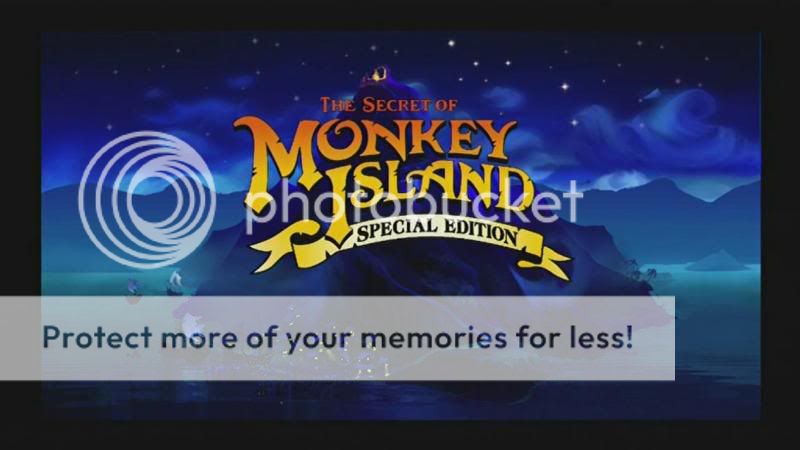
This is a review of the game. It contains spoilers. If you haven't played this game, by all means, PLAY IT. If you want to know my opinion first without being just flat out told, I'll write up my feelings on this, the new remade version of the game, as well as the original game and the series as a whole. I hope I won't rant too much, but hey.
The Secret of Monkey Island: Special Edition is exactly what they said it would be at E3. I was just as excited then as I was when I started playing, and expectations were high. It's a hi-res remake of the original SoMI, which came out in 1990. Featuring full voice-acting from the original actors chosen in Curse of Monkey Island, a live ensemble of fully reorchestrated music, brand new sound effects, and hand-painted backgrounds and characters. Not to mention an on-the-fly switch to the original SoMI as you play.
Part 1: The History of Monkey Island
First, a little history lesson. If you've played Monkey Island before you could skip this section. The Secret of Monkey Island was developed by a clever guy named Ron Gilbert (along with some friends) and released by Lucasarts in 1990, when the adventure game genre was getting into the swing of things with Sierra's King's Quest series and similar games. Lucasarts had released adventure games before on its innovative SCUMM system, but SoMI was one of a kind. An adventure game in which you can't die or fail. It's a comedy, and it's set in a romanticized self-parodying Caribbean island chain with swashbuckling pirates. And not every inventory item had only one use. Charming and witty, it was a huge success, introducing the gaming world to Guybrush Threepwood, a wannabe pirate battling the ghost pirate LeChuck. The game was inspired by the Pirates of the Caribbean rides at Disneyworld. This was a full 13 years before the successful PotC film franchise!
The next year, Ron Gilbert and company released Monkey Island 2: LeChuck's Revenge. Also using an updated SCUMM engine, it had ten times more effects, music, characters and puzzles. It continued the themes of the previous game, but it also went in a little more cartoony direction. Of the series, it's hard to say which of the two games is the best. Personally, I think SoMI is more iconic and memorable, but in terms of sheer gameplay and content, MI2:LC takes the cake.
In 1997, six years later, Lucasarts released the Curse of Monkey Island. Ron Gilbert was gone, but Michael Land was still there to make more music. The game system used an upgraded and adapted SCUMM engine. Most notably about the game was the art style; it was much more cartoony, as the characters were hand-drawn and colored. It was fun and entertaining, but compared to the previous two games, there is a slightly noticeable shift in playability. The game was still fun, though. It introduced the gaming world to Murray, the all-powerful talking skull.
Three years later in 2000 we saw what we thought would be the last Monkey Island game ever--Escape from Monkey Island, for PC and Playstation 2. It used a new engine based on Lucasarts' Grim Fandango engine. The game was creative and stylish, but the humor was a little more deadpan and the series had strayed from its roots. The game was so difficult to control and the puzzles so esoteric that I didn't even finish playing it--and I don't regret it. The engine was the biggest downfall for the game--no point and click interface made controlling it a pain.
After the most disappointing Monkey Island game ever, the series died down. Rumors still flew of Monkey Island 5 releasing in 2015, but nothing was definite. Lucasarts was silent. Only until this year did a resurgence thanks to fan support did Lucasarts return to the franchise, re-releasing SoMI in this Special Edition as well as working with Telltale Games in releasing Tales of Monkey Island, a 5-chapter game released once-a-month that can basically be considered 'Monkey Island 5'.
Part 2: The Special Edition
Now onto the meat of the game. Starting up the game, you're treated to the image of the old intro to SoMI--the shot of Melee Island with rolling clouds as the music starts up--but then it shifts into full widescreen, full visual effects, and amazing new music. The intro blew my mind and made me smile with big nostalgia glasses. A part of my youth is in this game.
The game plays exactly like it did 19 years ago. No part of the puzzles or the narrative have changed. Not even the inventory items. The characters are all there. The game has been faithfully remade as far as playability. This is not a bad thing. SoMI is an adventure game classic and deserves to be replayed by a new generation of gamers.
What HAS changed is still noticeable. Like they said at E3 and what I've mentioned above, the game is now in hi-resolution graphics. It's especially noticeable on a widescreen monitor. The backgrounds have all been painstakingly hand-painted to mimic the original game's, but with extra additions. The example they used in the E3 show was the ships behind the SCUMM Bar on Melee Island. There are several other additions. The Voodoo Lady's hut is more grandiose and spooky. The circus is more believeable. The streets of Melee are more run down and fitting. The Sea Monkey is more streamlined in its look and feel. The catacombs have a nifty 'molten lava hot air' blur effect.
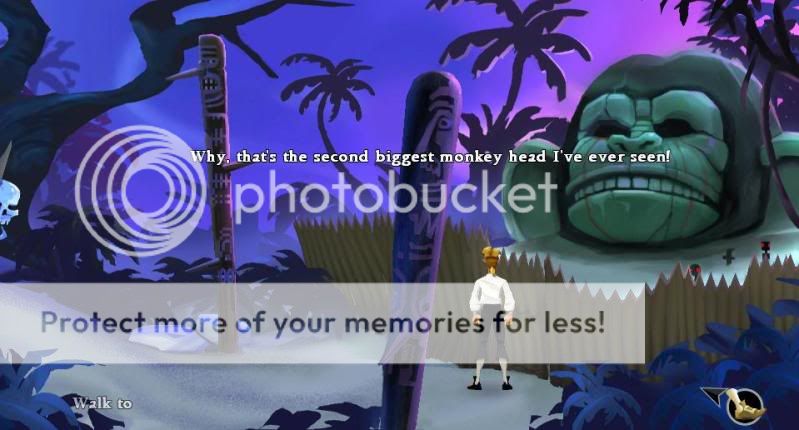
But I don't want to repeat myself. The backgrounds and art of this game are fantastic, and their biggest selling point. This game looks beautiful and is a breath of fresh air to the series. The water effects are particularly enjoyable. My biggest complaint is that the big "reveal" of Monkey Island near the end of part 2 (and for the most part, Monkey Island itself in part 3) is not as grand or awe-inspiring as it is in the original game. In the original, Monkey Island was bright with big green tropical trees and yellow sunny beaches.

In SoMI:SE, Monkey Island looks like it got bogged down with some bad weather.The trees are more dark, and I'm sure that's a tad more realistic and probably more fitting with the mythical island, but it was a big disappointment when they revealed the coast and I saw a dreary little green isle. There were a few other places that felt like they could've used more, like Hook's house and the cannibal village, but it's still a spot-on rendition of the original background, for the most part. Monkey Island needed more cheer, though.
Another noticeable change is the character models themselves. In a lot of good ways, they are better. They are prettier to look at, for sure, though the art style leans towards cartoony more than realistic, but this is a game with working vending machines in a supposedly romanticized piratey Caribbean. The style of the characters can be forgiven--in the closeups, the characters look fantastic. It's great to be able to chat with Spiffy the dog and actually see his closeup at long last. The best looking character in the game? LeChuck.
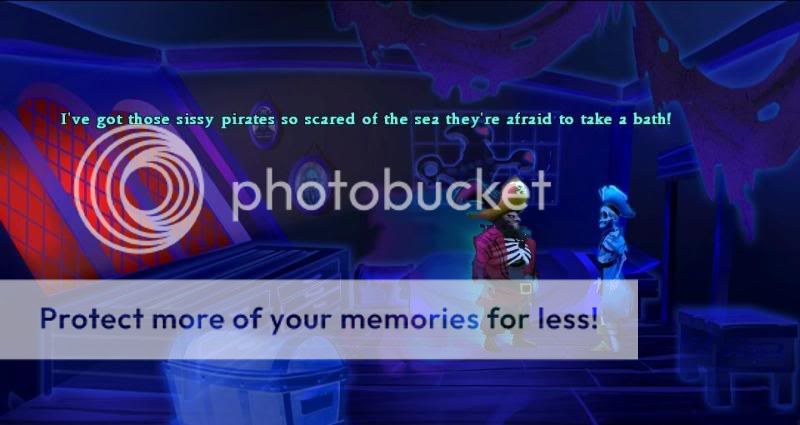
The Ghost Pirate got a cool treatment with a sexy red jacket (in fitting with his later appearances) and a cool translucent glowing 'trail' that follows his character in a very eye-catching way that just made me glued to his every move. I wished all the ghost pirates had that effect, but that would eliminate the unique feel of the main antagonist. Stan looked just as smug as ever, but part of me loves the original version with his cartoony giant mouth flapping at insane speeds. Even the troll on the bridge gets a nice upgrade--the man in the troll costume looks like George Lucas, which is who they were originally trying to make him look like (a foul-mouthed green troll munching on a red herring. Get it?)
The worst looking character models, I suppose, are unfortunately those of Guybrush Threepwood, your character the protagonist, and Elaine Marley, the love interest. That's sad to say, though. I might be saying that because playing through the game and seeing this new model was not like seeing the same little guy from the original--that it was almost like seeing a skinny impostor in Guybrush's shoes, but it's more than that. Maybe it was his hair.. I don't know. I DO know I want to cosplay as Guybrush Threepwood one day at a convention. I'll have to grow my hair out for the ponytail. As for Elaine Marley, it was sad that the new cartoony look of the characters forced the originally down-to-earth and reasonable Marley to a caricature of herself. Her closeup is hurt the most--in the original she's a strikingly beautiful and regal redhead. In the SE she's a skinny green-eyed "pir-ette".
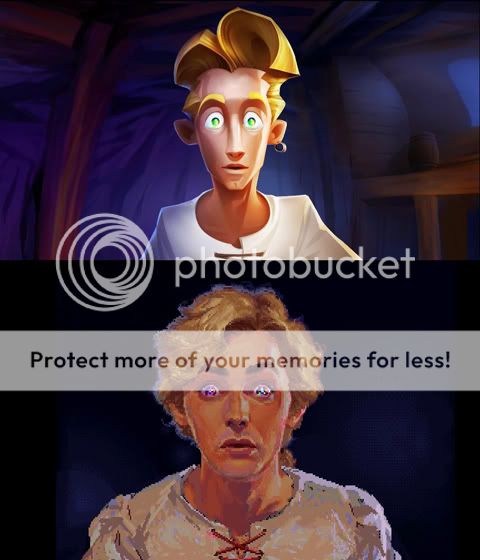
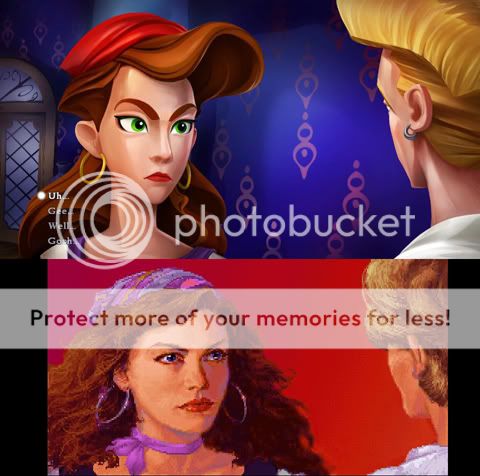
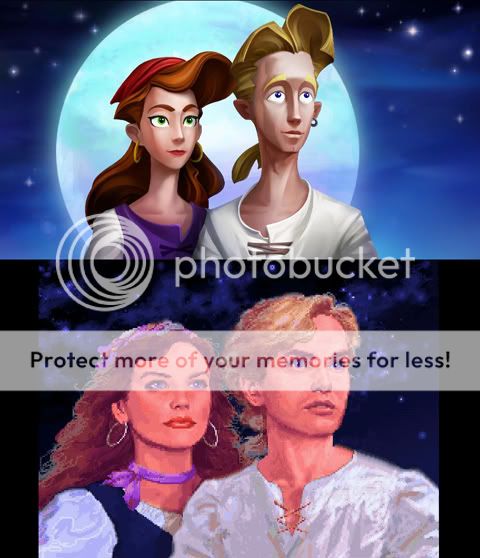
Oh, and Herman Toothrot's model looked a little off. In the original he had a cheeky grin and didn't look too run down for being a castaway for 20 years. In SE he looks like a sun-baked half-crazed freak castaway that would give Captain Jack Sparrow a run for his money. I don't know if that's what they intended. It's not a bad change--it's just different from how I knew Herman.
And then, the game also has other issues. More than once I noticed that, since the original's graphics were a bit more basic, they could get away with less accurate collision detection between sprites, and motion. Guybrush would just stick his arm out and hand stuff to people--in the old game that was easily forgiveable. In the SE it just looks a little off. I saw Stan just vanish from the side of the screen when he's supposed to fake you out and reappear as you leave. I saw a Cannibal slide across the floor as he left Guybrush behind the others. Stan would always wave his arms around in the air in front of Guybrush, even though his arm technically would appear behind Guybrush's sprite as they stood facing each other. It felt like Stan was using forced perspective and standing in the foreground. Stan would always walk around Guybrush in a weird way. In the original, his sprite would just pass through Guybrush's. Also, when the Voodoo lady reappears in her chair, she pops in before the screen flash for a split second. Plus during their dialogue, the Voodoo Lady spoke during one of Guybrush's lines. I don't know if these bugs are all consistent during each play-through; I've only played through the game once completely.
These little glitches are few and far between, but they are noticeable when they happen--they suck you out of the fun and make you realize 'oh yeah I'm playing the remake'.
Graphics aside, let's talk music and sound. This is where the series has almost always glowed. The theme song is a video game classic (they played it at Video Games Live for godssake) and the relatively small but very talented ensemble orchestra play through the soundtrack with a fantastic sound that fits the concept of the original little PC speaker effects and MIDI songs. Sound effects are equally refreshing and crystal clear. Lucasarts never fails in the sound department. Also noteworthy are the very mood-setting atmospheric sounds. In the CD version of the original game, there were a few atmospheric tracks, but this game has much more of them. In the crew quarters of the ghost ship, you can still hear a muffled version of the ghost crew's song on the top deck. Very clever and if you let the jungle/beach/forest sounds suck you in you will enjoy the game all the better.
There are moments in the game where the SE shines--during the whole 'behind the scenes' scene in the Governor's Mansion, the sound effects fit the 'actions' Guybrush make far better and make it much more amusing.
Finally on sound, another excellent selling point is the fact that the SE has full voice-acting on each and every line of dialogue (and narration, for that matter) from every character that was in Curse of Monkey Island, as well as new folks for the new characters. Rarely is a voice acting cast praised for its work--it's either standard or crap--but in this game, the cast is spot on and incredibly talented. Dominic Armato returns as Guybrush Threepwood and he knows this game like the back of his hand. It shows, and he reads each line with bright-eyed gusto. Alexandra Boyd is Governor Marley, and in CoMI she plays a snarky, clever Elaine. In this game, more fittingly, she plays a well-to-do but wise-to-the-world governor Elaine. She only reveals more of her nature when she falls in love with Guybrush, which is all the better. Earl Boen is LeChuck and Fester Shinetop (fittingly), but in CoMI he's a screeching, yelling evil pirate demon. In this game, LeChuck is still just a ghost pirate and has a little more dignity--so much the better. Patrick Pinney is back as Stan the salesman, and his smooth and smarmy voice gives whole new depth to the original Pitch Man, Stan.
But the recognizeable names from CoMI aren't the only ones worth praising. The cast itself is small--multiple roles are played by each person, and Lucasarts must've spared no expense getting such talented people. Each character has its own demeanor and feel and each line is superbly delivered. Some of the cast you may recognize from Cartoon Network shows, as well as older cartoons like Animaniacs(!), which further expands the slight cartoony feel of the game. My favorite voice? The guy who voiced the Navigator head, Jarion Monroe, who also did Captain Smirk, Mancomb Seepgood, and the cook.
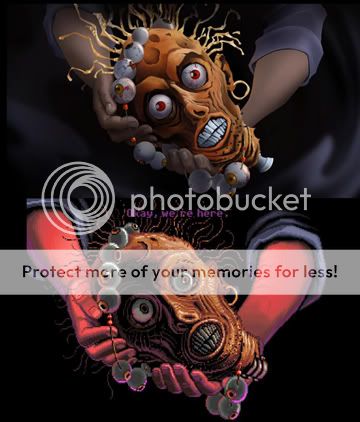
There is only one real complaint I have with the voice acting. During the massive amount of insult swordfighting you have to undergo to learn your insults and replies, you can't speed up the voice acting to burn through the duels. You have to listen to each line in full. That's a small complaint, since you can just switch to the original version and speed up the text for the duration of the dueling.
Which brings me to the gameplay. There's not much to say--the game itself hasn't changed, but the interface has. In the original, half the screen is taken up by the verb choices and your inventory. This has been eliminated to make the background bigger and more fitting for a widescreen monitor. To get to the verbs you either press V, Ctrl, or push a hotkey button for each verb. Initially it's a little hard to get used to, but soon you remember which of the more common verb hotkeys are (P for Pick Up, O for Open, U for Use, etc.). In addition, the inventory is now its own separate window, accessible by pressing I or Alt. This is okay for the most part, but when you have a lot of items and have to use the arrow keys to scroll through the items, it can get a little aggrivating. To get past the 'melting pewter mug' puzzle, I had to switch to the original version. In addition, conversations were a bit hard to get used to initially. In the original version, you just pick what you want to say with a click. In the SE, you can still do that, but it's a little more picky with where you click in relation to the choice. I found it easier to just scroll with the arrows and press enter. Not a big issue, but I'm trying to criticize an otherwise perfect game.
And let's not forget the hint system. In 1990, the internet wasn't prevalent enough to just allow people to look up a walk-thru to get past the puzzles. In 2009, everyone who has this game would easily be able to just look it up. Lucasarts thought ahead and included a hint system to bypass this lookup, as well as making the game more accessible for younger/less experienced/stumped players. Just a press of the H button and you're given a relatively vague hint. Still stuck? Press it again and you're given a more specific hint. If you still can't get it, press it again and the game will tell you exactly what you need to do next. The game really has no score, so there's no real detraction to doing this. Even with the hint system though, you will have to put the puzzles and solutions together to advance the plot, thus making you still feel like you're playing the game, rather than being led by the nose the whole time.
Finally, and perhaps one of my most favorite things to talk about, is the 'Version Hotswap'. Press F10 and you instantly switch from the SE game to a modified CD version of the original game. It shifts back and zooms out to include the verbs and inventory, reverts to non-widescreen, and all the voice acting is changed to text. It even shifts the soundtrack from the SE version to the CD version's classic tunes. A few minor lines have been edited/added/changed in some of the older original versions so the SE's 'original version' has the same dialogue as the SE, as well as a bit of a 'hybrid' of the best of the graphics for all the versions. It's fun to just go back and forth and literally experience the changes on the fly. It makes me happy to know that Lucasarts is now being run by the fans and they knew that people like me would miss the original version.
Part 3: Overall Opinion
The game is well worth the $10 price tag. It's available on XBox Live Arcade and Steam for download, and while it isn't 'replayable' exactly it's a classic and worth playing whether you're a long-time fan or new to the adventure game genre. At the end of the game after the credits, it says 'Guybrush Threepwood will return.' That's promising. I'm already itching for them to release Monkey Island 2: LeChuck's Revenge: Special Edition. If you're at this point in this blog entry, congratulations--GO GET THE FREAKING GAME. You will not be disappointed.
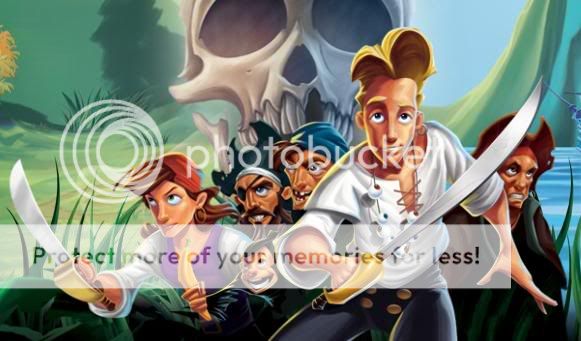
-
View User Profile
-
Send Message
Posted May 2, 2016-
View User Profile
-
Send Message
Posted Jul 31, 2009-
View User Profile
-
Send Message
Posted Jul 29, 2009But I didn't know what I would do to get ahold of you since you seem to have abandoned your IM personas. (Or maybe its just that I all but have as well and keep missing you *shrug*)
Anyway, back to the topic... I skipped over a big chunk in the middle for fear of spoilers, and thanks to your very well written review, I'm going to go buy this game first thing tomorrow morning.